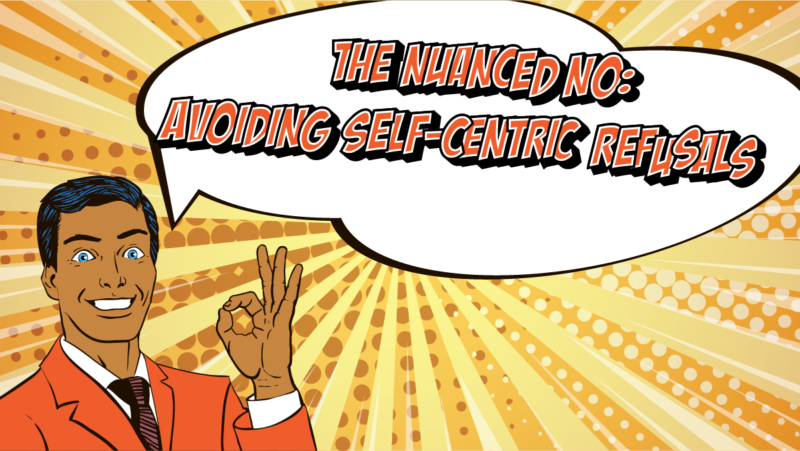In the professional sphere, the impulse to automatically say “yes” can be a powerful force. Whether driven by the desire to please, fear of conflict, or the ambition to excel, this reflex can sometimes lead us astray. However, true wisdom in decision-making comes from balance: weighing our needs against the needs of others and the situation at large. This blog introduces a nuanced approach to decision-making, represented through a quadrant that aids in understanding the multifaceted nature of our choices.
Deciphering the Quadrant of Decision-Making
To navigate the complex landscape of professional decisions, envision a quadrant that categorizes our responses based on two axes: the X-axis representing the spectrum from personal gain to broader considerations, and the Y-axis distinguishing between “yes” and “no” decisions. Here’s how the quadrant appears:
| Personal gain | Broader considerations | |
|---|---|---|
| Saying yes: | Decisions made to protect personal image or avoid discomfort, overlooking broader consequences. | Decisions consider the broader impact on the team, project, or client needs, ensuring a balanced, sustainable outcome. |
| Saying no: | Decisions based on personal convenience or discomfort, usually due to lethargy or unwillingness to get into action. | Decisions grounded in broader considerations, such as resource constraints, preserving long-term success and integrity. |
Beyond Personal Gain: Yes Decisions with Perspective
Saying “yes” can be as much about fear and insecurity as it is about ambition or eagerness. When we agree to tasks out of a desire not to appear incompetent or to protect our reputation, we might be overlooking essential factors like the feasibility of the commitment or its alignment with our team’s goals. By focusing only on personal gain or image, we risk committing to tasks that are unsustainable or misaligned with broader objectives.
For instance, consider agreeing to an unrealistic deadline. While this might temporarily boost your standing or appease a client, it could lead to subpar work, increased stress, and ultimately, a tarnished reputation. Instead, a “yes” should come after a holistic evaluation of the situation, including the task’s requirements, available resources, and potential impact on all stakeholders.

The Nuanced No: Avoiding Self-Centric Refusals
Conversely, saying “no” is often seen as a negative response, one that might indicate unwillingness or inflexibility. However, when framed correctly, a “no” can reflect a deep understanding of one’s limitations and a commitment to quality. The issue arises when our refusals are rooted solely in personal discomfort or convenience, ignoring the larger picture.
Imagine declining an opportunity to collaborate on a challenging project because it seems daunting or because it might require extra hours. While self-preservation is important, such a decision, based solely on personal considerations, can lead to missed opportunities for growth and collaboration. A well-considered “no” should factor in the project’s value, potential learning experiences, and the collective benefit, not just immediate personal concerns.
Evaluating Decisions for Endurance
The endurance factor is a critical aspect of any decision. Choices that cater only to immediate, self-centred needs are unlikely to provide long-lasting solutions. Sustainable decision-making requires evaluating how a “yes” or “no” will stand up over time, considering future scenarios, and the evolving context.
For instance, a “yes” that leads to chronic overcommitment can result in burnout, reduced quality of work, and eventual disengagement. Similarly, a “no” that avoids temporary discomfort at the expense of professional growth or team success can hinder long-term development and satisfaction.
Making Informed and Durable Decisions
To make decisions that are both informed and durable, integrate personal insights with a broader perspective. Consider the following steps:
- Evaluate the immediate and long-term impacts of your decision on yourself and others.
- Consider the alignment of the decision with your values, goals, and responsibilities.
- Reflect on past decisions and their outcomes to guide your current choices.
For example, before responding to a request, take a moment to assess not just how it will affect your workload or comfort but also how it contributes to team objectives, client satisfaction, and your professional growth. This comprehensive evaluation ensures that your decisions are both prudent and sustainable.
Balanced decision-making is an art that requires consideration of various factors beyond immediate personal benefits. By using the decision-making quadrant as a guide, professionals can navigate their choices with insight and foresight, ensuring that their “yes” and “no” responses contribute to enduring success and satisfaction.
Reflect on your recent decisions: Have they been driven by immediate self-interest or a balanced consideration of broader impacts? How might the quadrant framework reshape your approach to decision-making in the future? Share your thoughts and experiences, and let’s discuss strategies for making wise, enduring decisions in our professional lives.
If you want to receive free content to help you monetise your passion, click here.

